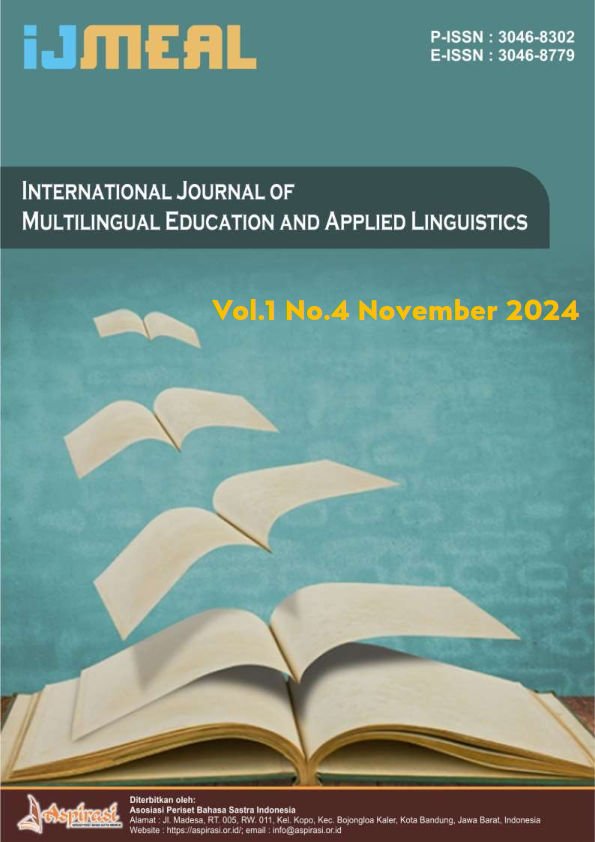Forms of Female Masculinity Power in the Novel Women Waiting in the Hallway to the Sea by Dian Purnomo
DOI:
https://doi.org/10.61132/ijmeal.v2i2.320Keywords:
Female Masculinity, Power, Novel, The Theory of Masculinity, Female Figures .Abstract
This study examines the representation of the power of women's masculinity in the novel Women Who Wait in the Aisle to the Sea by Dian Purnomo. The research problem focuses on how forms of masculinity power are displayed through female protagonists and how these characteristics reflect the configuration of masculinity according to Raewyn W. Connell's theory. This research aims to uncover how female characters build power, resistance, and independence through masculine attributes in the context of oppressive social structures. The method used is qualitative descriptive with reading and recording techniques as well as content analysis of novel texts. The results of the study show that Shalom figures represent the power of masculinity through courage, social dominance, mental toughness, rhetorical leadership, and physical endurance. These findings prove that women in literary narratives are able to internalize masculine attributes as a resistance strategy against social injustice. The conclusion of this study is that women's forms of masculinity power not only challenge conventional gender stereotypes, but also expand the understanding of women's roles in social structures through powerful and empowered literary representations.
References
S. Rahmawati, “Resistance of Multicultural Women in Indonesian Literary Works (A Feminist Perspective Study),” *Mabasan*, vol. 3, no. 2, pp. 108–122, 2019, doi: 10.26499/mab.v3i2.117.
YE Nugroho, Sumartini, and D. Prabaningrum, “Authority and Independence in Modern Indonesian Literary Works,” *J. Sastra Indones.*, vol. 12, no. 1, pp. 48–55, 2023, doi: 10.15294/jsi.v12i1.67472.
RW Connell, *Masculinities*. London & New York: Routledge Taylor & Francis Group, 2005.
RM Putri and RW Ikomah, “Female Masculinity in the Shadow of the Feminine in the Folktale I Marabintang,” *Kandai*, vol. 20, no. 1, pp. 109–120, 2024, doi: 10.26499/jk.v20i1.5921.
SAN Wahyudin, M. Qibtiah, and Sutejo, “Social Resistance of the Sangihe People in the Novel Perempuan Yang Menunggu di Lorong Menuju Laut by Dian Purnomo,” *Skripta*, vol. 10, no. 2, pp. 105–115, 2024. [Online]. Available: https://journal.upy.ac.id/index.php/skripta/index
RM Putri, “Stereotypes of women in Bima oral literature (Dae la minga, La Hila, and La Bibano): A feminist study,” Yogyakarta: Gadjah Mada University, 2019.
AN Wardani, “Hegemony of Masculinity in Thomas Hardy’s Under The Greenwood Tree,” *Satwika: Studi Ilmu Budaya dan Perubahan Sosial*, vol. 2, no. 2, pp. 68–78, 2019, doi: 10.22219/satwika.v2i2.7988.
Y. Citriadin, *Qualitative research methods (a basic approach)*. Mataram, 2020. [Online]. Available: http://www.academia.edu/download/35360663/METODE_PENELITIAN_KUALITAIF.docx
Sugiyono, *Quantitative, Qualitative, and R&D Research Methods*. Bandung: Alfabeta, 2016.
N. Rizqiyah and D. Hidayatullah, "Father Absence and Female Masculinity in Little Women (2019) and Yuni (2021)," *Jentera: J. Literary Studies*, vol. 13, pp. 1–12, 2024, doi: 10.26499/jentera.v13i1.6325.
G. Chairunyssa and DM Ula, “The Impact of Patriarchal Culture on Women in Households,” *Triwikrama: J. Ilmu Sos.*, vol. 1, no. 11, pp. 40–50, 2023, doi: 10.6578/triwikrama.v6i1.8105.
RD Putri, Y. Rahmi, and II Armalid, “The Impact of the Absence of a Father Figure on a Child’s Gender Role Development,” *Flourishing J.*, vol. 2, no. 6, pp. 447–456, 2023, doi: 10.17977/um070v2i62022p447-456.
A. Rostiyati and A. Priyatna, “Punk Women: A Culture of Resistance to Normative Gender (A Case in Cijambe Ujung Berung Village),” *Patanjala: J. Historical and Cultural Research*, vol. 9, no. 2, p. 261, 2017, doi: 10.30959/patanjala.v9i2.2.
P. Astuti, “Opportunities for Female Civil Servants to Obtain Structural Positions: A Study of the Quality of Gender Equality in Semarang City Government,” *J. Polit. Science*, vol. 3, no. 2, 2012, doi: 10.14710/politika.3.2.2012.68-83.
Kamarusdiana and S. Hidayati, “Women in Law Enforcement in Indonesia (Study of Women’s Roles in the Religious Court of DKI Jakarta),” *SALAM: J. Sosial dan Budaya Syar-i*, vol. 4, no. 1, pp. 27–42, 2017, doi: 10.15408/sjsbs.v5i1.7905.
FF Hesfi and L. Sofia, “Toxic Masculinity and Tendency to Bully Senior Male Students at Pesantren X,” *J. Ilm. Psychol.*, vol. 10, no. 3, pp. 519–529, 2022, doi: http://dx.doi.org/10.30872/psikoborneo.v10i3.
M. Syaiful, “Collective Violence in Urban Areas: Construction and Representation of Masculinity in Makassar Community Culture,” *ETNOSIA: J. Ethnografi Indones.*, vol. 2, no. 1, pp. 95–115, 2017, doi: 10.31947/etnosia.v2i1.2957.
E. Naden, A. Schepman, G. Bilton, and P. Rodway, “Resilience and mental toughness as predictors of anxiety, depression, and mental well-being,” *Ment. Wellness*, vol. 1, no. 1, 2023, doi: 10.4081/mw.2023.2.
SE Nepstad and C. Bob, "When do leaders matter? Hypotheses on leadership dynamics in social movements," *Mobilization*, vol. 11, no. 1, pp. 1–22, 2006, doi: 10.17813/maiq.11.1.013313600164m727.
A. Asmarani, “Women in Agrarian Conflict (Descriptive study of the role of women farmers in farmer mass organizations in agrarian conflicts, especially in forest areas in Palintang Village, Cipanjalu Village, Cilengkrang District, Bandung Regency-West Java),” International Women University, 2009.
FES Rahayu, Susilo, and Sunardi, "Persuasive Power as Reflected by Rhetorical Styles in Political Speeches: A Comparative Study of Barrack Obama and John McCain," *J. Cult. Arts, Lit. Linguist.*, vol. 4, no. 2, pp. 115–122, 2018, doi: http://dx.doi.org/10.30872/calls.v4i2.1360.
M. Huhtala, P. Fadjukoff, and J. Kroger, “Managers as Moral Leaders: Moral Identity Processes in the Context of Work,” *J. Bus. Ethics*, vol. 172, no. 4, pp. 639–652, 2021, doi: 10.1007/s10551-020-04500-w.
KH Dewi, “Tri Rismaharini's Androgynous Leadership: Strategizing 'Hegemonic Masculinity,'” *Politics: J. Polit. Undip*, vol. 7, no. 2, pp. 143–158, 2016.
P. Ehrkamp, “Risking publicity: Masculinities and the racialization of public neighborhood space,” *Soc. Cult. Geogr.*, vol. 9, no. 2, pp. 117–133, 2008, doi: 10.1080/14649360701856060.
Downloads
Published
How to Cite
Issue
Section
License
Copyright (c) 2025 International Journal of Multilingual Education and Applied Linguistics

This work is licensed under a Creative Commons Attribution-ShareAlike 4.0 International License.





